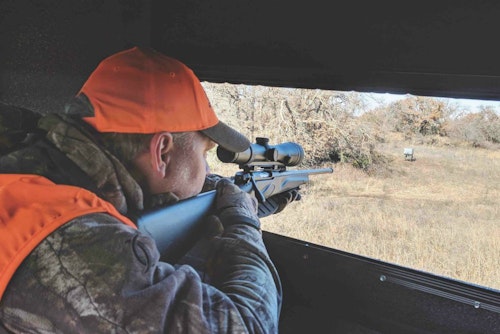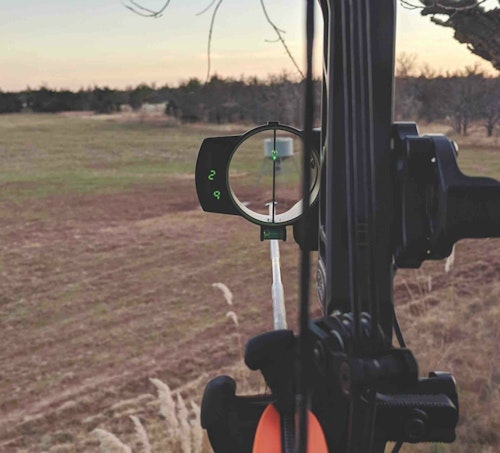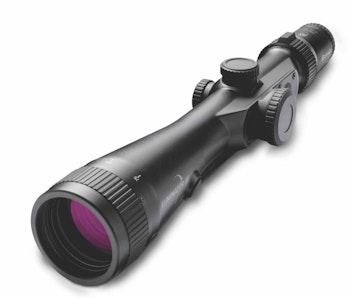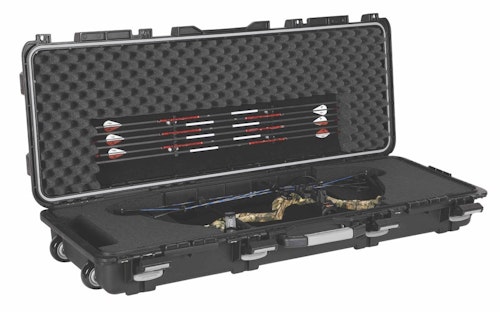It was late May, and I found myself daydreaming of the 166-inch buck I had recently taken in Kansas. Having held the rack of the tall-tined buck himself, it was easy to convince a friend of mine to apply with me. We had done so, and were now anxiously awaiting the draw results. When the results were posted to the Kansas Department of Wildlife, Parks and Tourism website, we found ourselves in the “Not Awarded” group — to our dismay. Time for a new plan.
After a little bit of discussion and research, I reached out to Greg Allen, owner and operator of Bend of the River Outfitters in western Oklahoma. I had hunted with Allen previously, and although I didn’t harvest a buck on that trip, I was impressed with his operation. We set up a new plan that included an early November date for a 6-day hunt in the neighboring state of Oklahoma. On that trip, I harvested a 140-inch Oklahoma buck, my first in the Sooner State.

Last fall, I planned a return trip to Oklahoma with hopes of harvesting two bucks, one with a bow and one with a gun. Again in early November, I landed in Oklahoma City in the middle of a snow and ice storm with heavy winds. Although I had timed the hunt along with the rut, the temperatures — dipping into single digits — were not favorable for a bow harvest. I hunted for 3 days and saw several good-sized bucks just out of range, but was only able to re-invigorate my acquired-in-the-past frostbite without ever flinging an arrow.
Luckily, I had a few days left to hunt and the gun season was now open. It remained cold, but the temperatures were now perfect for a little rutting activity. Feeling a little anxious about the idea of going home with two unused tags, I tried a little rattling and calling on the evening before my last day. From the ground-level deer stand overlooking the edge of a massive winter wheat field, I banged the Flextone Battle Bag Plus and grunted using the company’s All-N-One Boned Up deer call. I chose these calls because they packed easily into my carry-on bag.
Shortly after the second or third calling sequence, and right before the end of shooting light, a buck appeared out of nowhere. It wasn’t the 160-plus-inch buck I was hoping for, but time was running short. I quickly shouldered the Franchi Momentum in 6.5 Creedmoor, topped with a Burris Eliminator III scope and sent a Hornady 143-grain ELD-X bullet on its way. The buck dropped in its tracks; my second Sooner buck.
Kansas vs. Oklahoma
Steve Purviance, owner/president of Mt. Hide Outfitters, specializes in trophy whitetail and Rio Grande turkey, and has provided hunts in both states for 21 years. When asked to compare the trophy potential for whitetails in both states, he said, “Although rare, a 200-plus deer can pop-up in any region in both states. There’s pockets of better genetics where this will happen more frequently. These ‘trophy’ pockets will also have above-normal age class. I’ve seen these unique areas in every region in Oklahoma and Kansas.”
Purviance went on to unveil a little history on the subspecies of deer found in the two states today, “After the first settlers killed off the native deer. Kansas was restocked with a Northern subspecies of deer. Oklahoma was restocked with a Southern subspecies. However, after many decades, there’s virtually no difference in whitetail quality in the northern tier of Oklahoma and the southern tier of Kansas.”

Where to Go?
In Purviance’s opinion, the best region in Oklahoma for regularly tagging 170-plus, big-bodied bucks are the two rows of counties across the northern region of the state. “There will be debate, of course, because it is not by a wide-margin,” he said. “Many of the state’s top-end racks were not taken in that northern region. They’re much smaller bodied deer, but many of Oklahoma’s largest racks have come out of SE Oklahoma. However, those SE bucks are much harder to kill, mainly due to the rugged terrain and dense tree cover. There’s definitely big deer down there, but you’ll fill a wall of 170-plus NW Oklahoma bucks before you’ll tag one 190 in SE Oklahoma. The bottom line is Oklahoma has been, and will continue to be a sleeper state for trophy whitetails.”
Of course, getting started isn’t easy, and there are several options for hunting in Oklahoma, such as DIY on public land, leasing private land or a guided hunt. For those who are looking for a quick trophy, Purviance had this to say, “Like most places, well-managed, private land is where you need to focus for the best chance at a big deer. Reputable, guided-operations offer the best odds, of course. Good-quality leases can be procured, but many lessees don’t realize how much time and effort is needed to prepare a lease to its maximum potential. Therefore, many non-locals will learn that the extra money spent on a reputable outfitter was more than worth it.” “There are numerous public hunting areas across the state,” he continued, “plus the Oklahoma Game Department has recently implemented a great Walk-In program that shouldn’t be ignored. The local Walk-In tracts that I’m aware of are great hunting areas. All the public land tracts definitely have potential, you just need to do a lot of scouting and homework, including many hours in the field.”

When to Go?
Scheduling a trip to Oklahoma likely depends on several factors, including weapon preference, available time off, and time spent away from home during the fall. That said, Purviance has this to offer, “If your time is limited and you’re looking for a trophy whitetail, regardless of weapon, there’s no reason to limit yourself by bowhunting, due to the great timeframe of the firearm season. I personally love to bowhunt during the rut. But, if I have only 5 to 7 days to hunt, I’m bringing a firearm. Muzzleloader season is pre-rut, just as the bucks start searching for does. A cold-snap during this season can be unbelievable. I’ve taken most of my big Oklahoma deer on Halloween weekend with a muzzleloader. Rifle season starts the Saturday before Thanksgiving, and it runs 16 days, during the peak-rut across the state.”
OK Trophy Potential
Every state has the potential to produce giant whitetail bucks. If you are considering a trip to Oklahoma, Purviance offers this advice on when to pull the trigger, “This all depends on the individual and what that person considers a trophy. Most of the mature bucks harvested in Oklahoma by ‘trophy hunters’ fall in the range of 135-155 inches. A 5-year-old 145-incher is a great buck to most people, but to others that may sound a little small. However that’s the exact range I give my Kansas hunters. Most hunters tag a 140- to 150-class buck in both states over a five-day period. However, for those willing to hold-out for a 155- to 175-plus buck, there’s the legitimate chance for those in Oklahoma. If you’ve put yourself in the right area and have the dedication to put in the time, your chances are exceptional.”
Other Options?
On top of the hunt types mentioned earlier, purchasing land to hunt may also be a viable option for some. “It’s becoming more and more popular for deer hunters to invest in their own farms and ranches for whitetail management,” Purviance said. “When it comes to affordable land prices, and getting the most bang for your buck, Oklahoma is still unmatched. Not just for the deer hunter, but for all sportsmen. This is an extremely game-rich area with excellent Rio Grande turkey, quail, and waterfowl hunting, as well.”
Final Thoughts
If you have one, never give up on your dream to hunt whitetails in Kansas. It’s definitely a state worth applying for, and to be completely honest, it’s not that difficult to draw a tag. But in the event you don’t draw, or you’re just looking for another outlet to feed your whitetail obsession, don’t hesitate to give Oklahoma a try.
Sidebar: Multi-Tasking Optics
Ensuring you arrive with all of the gear you need for a whitetail hunt is crucial. One way to eliminate the need for extra items is to use gear that performs multiple tasks. Doing this also shaves weight from your packed bags, especially important if you are flying to your hunting destination. New aiming devices — bowsights and riflescopes — that have built-in rangefinding abilities are one such gear item.
Burris Oracle Rangefinding Sight
This rangefinding sight is activated by a push button to instantly calculate and display the exact aiming point for any distance and shot angle. The built-in inclinometer maintains the correct distance at any angle. The Oracle features a 20-yard fixed pin as a reference point, and a rear sight that eliminates bow grip torque and the need for a string peep sight, improving visibility in low light. The Oracle is compatible with arrow speeds from 200 to 420 fps, and it stores two different trajectory curves for different arrows or draw weights.
Burris Eliminator III
This LaserScope is both innovative and effective for shooting both near and far. The triple combination of outstanding optics, pinpoint laser rangefinding, as well as precision trajectory compensation for your preferred ammunition make it a great all-around riflescope. At the push of a button, the Eliminator III determines target distance, factors in bullet trajectory, and illuminates a holdover dot on the reticle post. The built-in laser rangefinder features 1,200-plus yards ranging capability, accurate trajectory compensation at any magnification, and an integrated inclinometer that automatically compensates for shots at any angle.
For more information, visit www.burrisoptics.com.
Sidebar: Airline Travel Tips
Airlines are concerned with arrivals and departures, but not as concerned with the treatment of your gear. Therefore, protecting your gear is vital. Using a high-quality travel case is the only option to make sure your gear arrives in one piece. That said, always verify the sight-in of your bow and/or rifle after arriving at your hunting destination.
Rifles and handguns can only be transported on a commercial aircraft unloaded and packed in a locked, hard-sided case as a checked bag. Ammunition is also prohibited in carry-on baggage and must be checked. Likewise, assembled bows must also be transported as checked luggage. “At the airport during the check-in process, a passenger should go to the airline ticket counter to declare all guns, ammunition and any firearm parts. Ammunition should be transported in its original packaging,” TSA personnel recommends. A few days prior to traveling, visit the website of the airline you are traveling with to verify any specific requirements, too.
Note that oversize cases may not arrive at your destination with your other luggage. A few airports, especially smaller ones, as well as the airlines themselves, have specific procedures for oversize cases. In many instances, oversized luggage will be delivered all at once to a common area, such as the airline’s baggage office. If you don’t see your gun or bow right away, don’t fret, but also don’t be afraid to inquire about its whereabouts with an airline official.
Plano Field Locker Compound Bow Case
This hard-sided case isn’t only rugged — it is secure, thanks to reinforced padlock gates and solid construction throughout. Arrow storage is provided inside the lid, while easy-glide, ball-bearing wheels make for easy wheeling to your vehicle or the airline counter.
Plano All Weather (AW2) Rifle Case
The All Weather cases defend your firearms from damage and the elements. Rugged, industrial-strength construction and a continuous Dri-Loc seal create a watertight and dust-proof shield that protects your gear even in the most extreme conditions. Additionally, heavy-duty, dual-stage lockable latches and a built-in pressure release valve also help the cases withstand the continuous bumping and jarring of airline travel.
For more information, visit www.planomolding.com.










